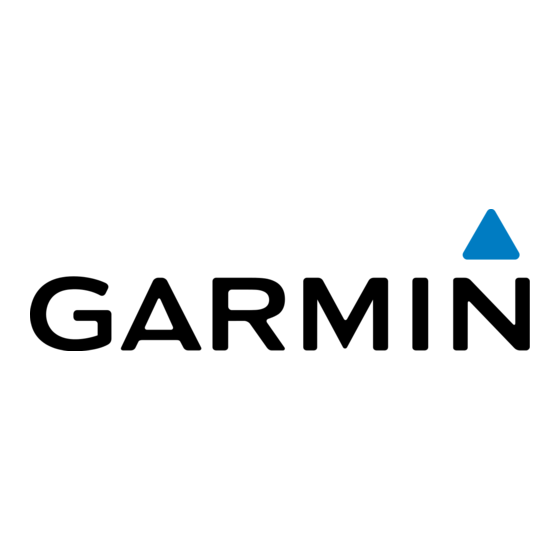Garmin GPSMAP 8000 Series Manuale d'uso - Pagina 10
Sfoglia online o scarica il pdf Manuale d'uso per Sistema GPS marino Garmin GPSMAP 8000 Series. Garmin GPSMAP 8000 Series 43. Installation instructions
Anche per Garmin GPSMAP 8000 Series: Manuale d'uso (36 pagine), Manuale di avvio rapido (4 pagine), Manuale di istruzioni (15 pagine), Manuale di istruzioni per l'installazione (14 pagine)

4
Select a destination.
You can select Next Page or Previous Page to view
additional information or to show the location on a chart.
Waypoints
Waypoints are locations you record and store in the device.
Marking Your Present Location as a Waypoint
From any screen, select Mark.
Creating a Waypoint at a Different Location
1
Select Info > User Data > Waypoints > Create Waypoint.
2
Select an option:
• To create the waypoint by entering position coordinates,
select Enter Coordinates, and enter the coordinates.
• To create the waypoint using a chart, select Use Chart,
select the location, and select Select.
Marking an SOS Location
You can mark an SOS location. When a Garmin VHF radio is
connected using NMEA 2000, you can select different SOS
types, such as Man Overboard and Piracy.
1
From the Home screen, select SOS.
2
Select the SOS type.
3
If necessary, select OK to navigate to the man overboard
location.
If you selected OK, the chartplotter sets a direct course back to
the location. If you selected another type of SOS, the call details
are sent to the VHF radio. You must send the call using the
radio.
Viewing a List of all Waypoints
Select Info > User Data > Waypoints.
Editing a Saved Waypoint
1
Select Info > User Data > Waypoints.
2
Select a waypoint.
3
Select Review > Edit.
4
Select an option:
• To add a name, select Name, and enter a name.
• To change the symbol, select Symbol.
• To change the depth, select Depth.
• To change the water temperature, select Water Temp..
• To change the comment, select Comment.
Moving a Saved Waypoint
1
Select Info > User Data > Waypoints.
2
Select a waypoint.
3
Select Review > Move.
4
Indicate a new location for the waypoint:
• To move the waypoint while using the chart, select Use
Chart, select a new location on the chart, and select
Move Waypoint.
• To move the waypoint using coordinates, select Enter
Coordinates, and enter the new coordinates.
Browsing for and Navigating to a Saved Waypoint
The Auto Guidance feature is based on electronic chart
information. That data does not ensure obstacle and bottom
clearance. Carefully compare the course to all visual sightings,
and avoid any land, shallow water, or other obstacles that may
be in your path.
Navigation with a Chartplotter
CAUTION
When using Go To, a direct course and a corrected course may
pass over land or shallow water. Use visual sightings, and steer
to avoid land, shallow water, and other dangerous objects.
NOTE: Auto Guidance is available with premium charts, in some
areas.
Before you can navigate to a waypoint, you must create a
waypoint.
1
Select Info > User Data > Waypoints.
2
Select a waypoint.
3
Select Navigate To.
4
Select an option:
• To navigate directly to the location, select Go To.
• To create a route to the location, including turns, select
Route To.
• To use Auto Guidance, select Auto Guidance.
5
Review the course indicated by the magenta line.
NOTE: When using Auto Guidance, a gray segment within
any part of the magenta line indicates that Auto Guidance
cannot calculate part of the Auto Guidance line. This is due to
the settings for minimum safe water depth and minimum safe
obstacle height.
6
Follow the magenta line, steering to avoid land, shallow
water, and other obstacles.
Deleting a Waypoint or an MOB
1
Select Info > User Data > Waypoints.
2
Select a waypoint or an MOB.
3
Select Review > Delete.
Deleting All Waypoints
Select Info > User Data > Clear User Data > Waypoints >
All.
Setting and Following a Direct Course Using Go To
When using Go To, a direct course and a corrected course may
pass over land or shallow water. Use visual sightings, and steer
to avoid land, shallow water, and other dangerous objects.
You can set and follow a direct course from your current location
to a selected destination.
1
Select a destination (Destinations).
2
Select Navigate To > Go To.
A magenta line appears. In the center of the magenta line is
a thinner purple line that represents the corrected course
from your current location to the destination. The corrected
course is dynamic, and it moves with your boat when you are
off course.
3
Follow the magenta line, steering to avoid land, shallow
water, and other obstacles.
4
If you are off course, follow the purple line (corrected course)
to go to your destination, or steer back to the magenta line
(direct course).
Routes
Creating and Navigating a Route From Your Present
Location
You can create and immediately navigate a route on the
Navigation chart or the Fishing chart. This procedure does not
save the route or the waypoint data.
NOTE: The offshore Fishing chart is available with premium
charts, in some areas.
1
From the Navigation chart or Fishing chart, select a
destination.
CAUTION
9
